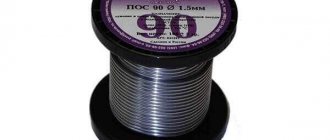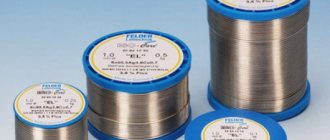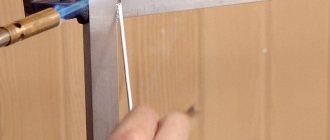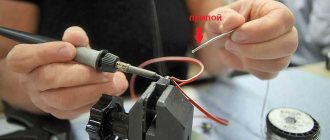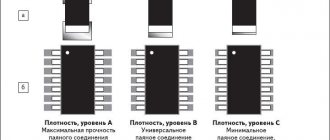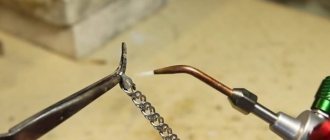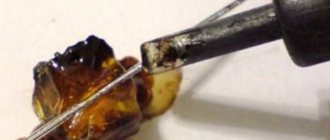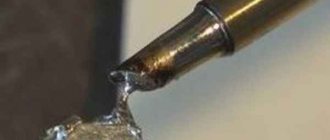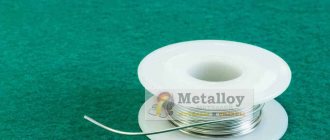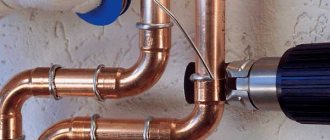Varieties
Silver solders are divided into several varieties depending on their silver content.
Solders with a low content - up to 40% - are used for soldering workpieces made of steel and non-ferrous alloys. Such compositions have insufficient strength to connect parts thicker than 3 mm.
Compositions with an average content of 40 to 60% are used for soldering copper, nickel and steel parts that experience significant static loads, shock and vibration.
Silver solder with a high percentage - from 65% is used when soldering especially critical seams, such as band saws and wire connections. The high silver content allows for excellent electrical conductivity.
Physico-chemical properties and composition of silver solder
The properties of a particular silver solder are determined by its composition. Silver solder, which is used for multi-stage soldering, must have a sufficiently high melting point. This is necessary so that during surfacing of the next layer the previous one does not melt and leak into the solder gap. The average melting point is 600 °C.
Chemical composition of silver solders
Properties of silver solders
To create such solder, you will need to take 33 parts of cadmium, 16 parts of zinc and 20 parts of copper for 30 parts of silver. Like any composition with a low content of the main element, it is not resistant to high loads, shocks and vibrations.
Increasing the silver content to 50% will increase the fluidity of the melt and the ability of the solder seam to withstand static and dynamic loads. It can also be used for soldering in several layers, but special care and caution will be required.
Properties of medium melting alloys
Pure silver is a soft metal and is therefore not suitable for work.
Mostly, craftsmen use mixtures that contain zinc, nickel, aluminum, copper, and cadmium. In addition to silver, silver solders also contain zinc and copper. A seam made with this composition is strong and durable. Compounds of silver, copper, zinc have a high melting ability. They are used for silver solder. To control its percentage composition, GOST 19746 74 was developed. Solders, silver grades, are always indicated in the instructions for the products. The soldering seam obtained in this way is durable.
Modern soldering processes involve the use of silver solder, which, when connecting nodes, is suitable for step soldering. Such work requires the use of an alloy that can withstand temperatures of 600°C.
The solder contains ingredients such as 30% silver, 20% copper, 16% zinc, 33% cadmium. The alloy is very brittle and is intended for soldering materials that are not subject to vibration. The composition with the amount of silver increased to 52% is very fluid, but withstands loads well during multi-stage stages of soldering materials.
Silver solder has high strength, is resistant to corrosion in aggressive environments, has a low melting point, and high thermal conductivity. During operation, it completely fills the gap between the parts being soldered and fits well on the metal surface.
When working, you need to make sure that the solder completely fills the gap between the parts.
An alloy of 28.5% copper of the PSr-72 grade has high ductility. When working on creating solder with your own hands, you should remember that its melting point with copper decreases when alloyed with lithium. The resulting alloy is used for soldering steel materials that are resistant to corrosion. To reduce the melting temperature of the solder, tin is added to it in an amount of 35 to 70%. The resulting alloy allows you to solder various materials, avoiding the formation of cracks.
Specifications
The most common silver solders include elements such as Ag, Cu, Zn, Sn, Mn, P, Cd.
| Brand | Availability of elements, % | |||||||||
| Ag | Cu | Zn | Sn | Mn | P | Cd | Impurities, max | |||
| Pb | Fe | |||||||||
| PSr72 | 72 | Track | — | — | — | — | — | 0,005 | 0,1 | |
| PSr71 | 71 | Track | — | — | — | 1 | — | 0,005 | 0,15 | |
| PSr70 | 70 | 26, | Track | — | — | — | — | 0,05 | 0,1 | |
| PSr65 | 65 | 20,0 | Track | — | — | — | — | 0,1 | 0,1 | |
| PSr62 | 62 | 28,0 | — | Track | — | — | — | 0,005 | 0,15 | |
| PSr50 | 50 | Track | — | — | — | — | — | 0,005 | 0,15 | |
| PSr50 Kd | 50 | 16,0 | 16,0 | — | — | — | Track | 0,1 | 0,1 | |
| PSr37.5 | 37,5 | Ost | 5,5 | — | 8,2 | — | — | 0,05 | 0,1 | |
Silver solders with a content higher than 72% are used in jewelry.
Features of choice
Selecting a solder that is best suited to a specific combination of materials, thickness and configuration of workpieces, and requirements for mechanical and thermal loads on the seam is not an easy task. To create strong, durable seams that are resistant to static and dynamic loads, experienced craftsmen recommend choosing silver solder with a medium or high content of noble metal. They may include Ni, Cu and Pb. For soldering pipelines and containers used in refrigerators and air conditioners, only mixtures with a high Ag content are suitable.
Soldering jewelry
When soldering jewelry, the high cost of the base material justifies the use of solders with a silver content of 85 to 100%, or pure silver. This silver solder is produced in the form of wire with a diameter of 1 mm.
When creating seams intended for use at elevated temperatures, compounds containing lead or tin are not suitable. Due to their low melting point, they will weaken the entire connection. In this case, silver-copper soldering materials are chosen.
Solder selection
The selection of the appropriate type of mixture when soldering steels is carried out in accordance with the structure of the raw material. Solders containing silver make it possible to produce strong seams with a uniform, dense cut. These types have increased anti-corrosion properties, which makes it possible to use them with substances exposed to aggressive environmental influences.
For the repair of fittings, various pipes and other substances with a copper content of more than 57%, a structure marked PSR-12 is used
For structures with high requirements for reliability and strength, it is important to use more saturated materials. You need to know that there are products with a silver content of up to 70%
As an alternative to tin soldering, silver-zinc is used. The price of such a product is high, but it pays off when used with steels of increased brittleness. Common solder in radio engineering is POS-40 solder, which contains 2.5% silver.
Do-it-yourself flux preparation
There are several ways to prepare flux at home. Basic tools and materials that may be needed during manufacture:
- A gas stove heats the substance to a liquid state.
- A spoon is used to dose the powder.
- A steel container or mortar is used to grind solid rosin into small particles.
- Sealed storage container.
After preparing the powder, it is necessary to prepare a solvent. The element is heated to the required temperature, usually a solution with proportions of 1 to 1 is used. The solution prepared at home is mixed with a spoon until all particles transform into a liquid state. During the process, the mixture acquires a yellowish tint.
Advantages
The melting point of pure silver solder is 962 °C, the seam is ductile and soft. To save precious metal and produce stronger connections, other metal elements are added to the solder.
The advantages of a particular solder depend on the composition and percentage of additives.
The general advantages of silver solders are:
- high fluidity;
- strength;
- corrosion resistance;
- suitability for working with a wide range of materials;
- low resistance to electric current.
The lower the Ag content, the lower the operating temperature of the composition. The labor intensity and energy intensity of soldering are proportionally reduced.
Silver percentage
The silver content of silver solder also affects other physical properties such as thermal and electrical conductivity.
Low content
Compositions with low silver content are widely used in industry for soldering metal workpieces.
They are also used in electrical engineering - a composition containing only 2% Ag, 62% Sn and 36% Pb is very popular in electrical and radio installations.
It is characterized by high conductivity and increased fluidity, which facilitates the soldering process.
Average percentage of silver
Compositions containing from 40 to 60% are recommended for seams operating at low temperatures.
Seams soldered using PSr40 are distinguished not only by their high strength and ductility, but also by their ability to withstand high dynamic and periodic loads.
Solder PSr40
Solder PSr45
PSR45 is used when working with joints up to 3 mm thick. Also resistant to vibration and aggressive environments.
High percentage of silver
PSr65 solder, to which 2% copper and 14% Zn are added, is specially designed for soldering band saw blades. It has increased tensile and bending strength.
The PSr70 composition provides excellent conductivity and is used for soldering critical connections of electrical components and wires. The minimum connection resistance is important both in microelectronics and in powerful electrical installations for industrial use and at generating stations. The high price hinders its widespread use.
Solder PSr60
Solder PSr70
Economic considerations also prevent the wider use of high-silver formulations outside of scientific research, military and jewelry applications.
Silver Soldering Tools
If you have the appropriate tools, you can carry out soldering yourself. The most difficulties arise when working with stainless steel. The recommendations are as follows:
- To begin with, the surface is cleaned from various contaminants; any mechanical method can be used. Most often, paint and dirt are removed with a brush, after which the surface is degreased using a special composition.
- Selected flux is laid out on the future soldering area. Application technology largely depends on what material is used. The flux must be distributed evenly, otherwise the quality of the connection may be poor.
- To process a large area, a special torch is used to heat the metal to the required temperature. The first sign that the material is ready for soldering is a change in its temperature.
- After reaching the required state of the workpiece, the selected solder is supplied. It should be spread over the surface in an even layer.
- The entire seam is passed from start to finish. A little time is given for the material to cool, after which the workpiece is heated a little more to gradually reduce the temperature.
Beautiful chains, bracelets, earrings, forks, spoons, silver glass holders decorate a person’s life. But over time, products made of precious metal break down and need repair and restoration. To perform such work you will need silver solder. For 925 standard, you can make it yourself, using the advice of professional jewelers.
For the work you will need the following materials and tools: regular and irregular-shaped soldering irons, solder casting, scrap silver. The easiest way to repair a broken chain is to take it to a jeweler. But if you wish, you can cope with the problem at home, saving money.
To perform such actions, it is important to have information about the physical and chemical characteristics of the material. The melting point of silver is 960 degrees Celsius. From the jewelers' point of view, this is an average figure. For example, copper can melt at 1083ºC, gold melts at 1063ºC.
Depending on the components that make up the silver, their temperature will vary. In order to accurately find out the characteristics of the alloy, you can use technical reference books. Marking of silver solders implies a sequence of Russian letters and numbers. The numbers characterize the percentage of noble metal in the solder.
To repair a silver product, you need to prepare a soldering iron and clean the surface of the product. Silver solder allows you to make strong, tight seams that are resistant to corrosion. When repairing jewelry, solder containing more than 70 percent silver or a special soldering paste is used.
At home, alloys of silver, zinc, copper, and cadmium are suitable for repairing small jewelry. The optimal composition for “beginners” will be the following: 45 parts silver, 25 copper, 30 zinc. Melting of the components is carried out in a muffle furnace; flux is required. The finished mixture is poured onto a substrate and, after cooling, passed through a rolling machine to obtain thin sheets.
Their thickness should not exceed 0.5 mm. For home soldering, you need sheets whose width is 1-3 mm. For home soldering of silver jewelry, it is not advisable to use compounds containing cadmium. This metal causes serious health problems. The soldering area is exposed to air and oxides are formed.
To prevent this phenomenon, colophonium (flux) is used in home soldering. When melting silver solder, it is important to ensure that the flux is evenly distributed over the surface being processed. If you have doubts about your skills and theoretical knowledge of the soldering process, it is better to contact a professional jeweler.
It is not recommended to use compositions containing cadmium at home, since evaporation has a negative impact on health. To prevent the oxidation process and other negative reactions, you can use flux (colophonium). It is important that it is evenly distributed over the surface of the metal.
If a problem occurs in the form of a broken silver chain, do not despair and rush to get rid of the item. A jeweler will help correct the situation. However, it is not always possible to turn to him for help.
In addition, such a service will not be cheap and will be almost half the price for the item itself. You can try to solve the problem yourself and solder a silver chain at home using available tools.
February 15, 2021, 00:46
Tips to remember when soldering silver or other precious metals.
Each year I teach about 50 people who are new to working with silver, gold, copper and brass. It is especially noticeable that students are beginners when observing the metal soldering process, especially in the operation and handling of torches.
I cannot personally help every student and be present in their further development of soldering skills. So after the initial training, I would like to give my eager students the following tips and tricks for successfully soldering jewelry, and to once again remind them of what they have already learned.
I recommend placing this handy cheat sheet in your workshop and using it whenever you need it.
What fluxes are suitable
To obtain a high-quality and durable seam, it is necessary to treat the surfaces of the workpieces with fluxes before soldering. These auxiliary materials clean the surface of chemical contaminants and oxide film, preventing its reoccurrence.
Fluxes also help increase melt flow and wettability of the workpiece surface with silver solder.
One of the most popular flux materials among solders is borax.
Soldering borax
Solder paste can be prepared as follows:
- Pour borax powder into a heat-resistant mixing container.
- Add water in a thin stream and stir thoroughly.
- Heat until completely transparent.
- Drain the liquid phase, grind the sediment to the consistency of sour cream.
The paste is suitable for silver solders with a melting point from 490 to 910 °C.
A composition containing:
- 35% boric anhydride B2O3;
- 43% KF;
- 22% K₂B₄O₇.
Solder paste
Potassium fluoride is calcined for 3-4 hours, then all components are thoroughly mixed and heated until melted. After cooling, the material is crushed and ground to a fine powder. It should be kept in an airtight container, since it actively absorbs water vapor contained in the air, thereby losing its working qualities.
For soldering porous materials, a flux based on potassium tetrafluoroborate is used. In order to obtain such a composition, you will need to use extremely strong and dangerous hydrofluoric acid.
If you do not have sufficient skills in handling strong chemicals, it is safer to buy the composition in a store.
Technology for creating silver solder at home
When creating solder with your own hands, you will first need to melt silver and other components, and then cast the resulting melt into a special container - ingus.
The process begins with the preparatory phase. A cardboard square is placed at the bottom of the melting spoon, and a sheet is placed on it so that its edges wrap around the edges of the spoon. This is done to speed up the melting process.
Silver solder cutting
Using jewelry or laboratory scales, the charge is weighed and divided into portions of 18-20 g. For one portion, take 6 g of 875 silver and 40% pure metal. Iron dust is removed from the mixture using a strong magnet.
Next you should add finely chopped copper. It is taken at the rate of 1 part copper to 3 parts silver mixture. The flux will be borax powder; it is added to 10% of the total volume.
The next stage is melting. You should light the burner and adjust the combustion mode. The melting spoon is placed in the upper, hottest part of the burner flame. The charge begins to melt and accumulate at the bottom of the melting spoon.
Ingus should be coated in advance with a thin layer of wax, heated and kept ready next to the burner.
Once all the charge has melted, you can begin the final stage - casting.
The spoon is removed from the heat and without the slightest delay, without allowing the molten metal to cool, the spoon is poured into the ingus in one smooth movement. Ingus is cooled with a stream of water. After the casting has completely cooled down and the crystallization processes have completed, it is removed from the ingus, turning it over and knocking if necessary.
When making your own solder, the following precautions should be observed:
- Carry out work in a well-ventilated area.
- Use personal protective equipment: goggles or a transparent shield, protective gloves made of split leather or tarpaulin.
- Carry out work on a fire-resistant base.
- Immediately after heating and casting is completed, turn off the burner.
- Do not leave equipment unattended.
Making silver solder with your own hands is not a very difficult job, but it requires concentration and a certain skill.
Melting solder
By melting the metals that are part of the mixture, silver solder for steel is obtained in a crucible. Place the gel in the forge, having prepared special equipment: borax, a container with water, a coal mixture, an iron hook, a crucible. First you need to melt the refractory metals, and then low-melting metals are added to the mixture. To make high-quality solder with your own hands, the work must be divided into two stages. First, the crucible is removed from the furnace and the metal is combined in a container filled with water. As a result, fine-grained drops of solder appear. They are dried, then melted again, covered with borax. Once the metal is completely melted, it is poured into special molds. After hardening, the bars or tiles are rolled into thin strips. For subsequent use, they are cut on a lathe into thin wire.
Materials and tools for creating solder
To make silver solder yourself, you should prepare the following materials and equipment:
- Silver scrap.
- Additive materials (Zn, Cu, borax as a flux and others according to the recipe).
- Laboratory or jewelry scales.
- Gas burner mounted on a stand that prevents it from tipping over.
- Melting spoon.
- Metal scissors.
- Container and spatula for mixing ingredients.
- Abrasive paper.
- Ingus.
Silver scrap
The table on which work will be carried out must have a fire-resistant coating.
Engineering works
For technical work, silver solders are used containing up to 80 parts of silver, 16 parts of copper, 4 parts of zinc. Of interest are jewelry silver solders, the composition of which is: 2.8 parts brass, 7 parts silver, 0.2 parts zinc. Before starting work, the brass is cleaned of the oxide film. To obtain 10 grams of such solder, 999 silver is melted.
Brass is added to the liquid metal and mixed in a spoon. After complete melting, the mixture is combined with zinc, and the resulting composition is rolled. Next, the rolled sheet is cut with scissors and weighed on a scale. For effective work you need: a spoon, sandpaper, a gas burner, scales, folds, a stirring spoon.
